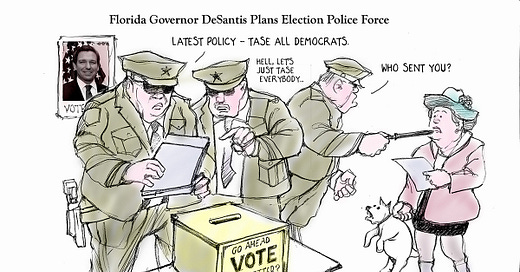The DeSantis win was voter intimidation 101
or how Election Police ramped up Ron's presidential run
Next Tuesday, Donald Trump is expected to announce he is running for president. He is sitting on more than $350 million in his PAC and can easily raise more. Plus, Trump can garner the support of as many congressional and gubernatorial politicos as he wants.
Well, the foregoing was true as of November 8th…it’s trusim is in doubt now. But, it would be idealistic to assume that Trump is powerless and friendless after the GOP failed to meet its own and the corporate media’s expectations.
That said, if you followed election night coverage, political analysts right of center (and many slightly left of center), seemed interminably focused on the reelection victory of Governor Ron DeSantis. It is as if the reelection of Democratic Governor Laura Kelly in barn-red Kansas or the election of Wes Moore to the governorship in Maryland means nothing. Moore, an African-American politician, won with raw votes and percentages in line with white male Democratic candidacies in the Old Line State.
It would have been interesting had a Leftist realist been on the dais of political analysts on election night and said something like this:
“DeSantis’ reelection victory was built on Election Police intimidating Democratic voters in Democratic counties. It’s unlikely that nearly a million fewer Democrats decided to show up at the polls between 2018 and now — it’s about the Right, officially in Florida, but unofficially elsewhere scaring would be Democratic voters with violence, guns, and arrest.”
The numbers in Florida are telling.
In 2018, there were 4,718,720 registered Republicans, 4,975,895 registered Democrats, and 3,588,518 Independents.1 By 2022, there were 5,259,406 Republicans, 4,966,873 Democrats, and 3,974,540 Independents.2 I’ll spare you the math. The GOP added more than 540,000 voters to its roles, Independents grew by more then 386,000, and the Democrats stagnated losing 9,000 plus voters.
The above explains the results somewhat in Florida, but it’s intellectual laziness to rely on party registration changes alone to explain the 2022 outcome.
In 2018, Ron DeSantis bested Andrew Gillum 4,076,176 votes to 4.043,723.3 That’s a margin of less than 33,000 votes. In 2018, a total of 8,220,561 people voted and DeSantis and Gillum represented more than 98% of that total vote.
In 2022, a mere 7,765,218 voted. That’s a sizable drop in a hotly contested gubernatorial election. DeSantis’s numbers went up from 4,076,723 to 4,611,094.4 That’s explanable on the increase in GOP registration alone — he drew 534,371 more votes and party registration grew by a little more than that in the past 4 years.
On the Democratic side, 940,397 fewer voters showed up. Why? The Florida Election Police (officially the Office of Election Crimes and Security).
It’s worse than that.5 People were being arrested6 with enough frequency during early voting in the Sunshine State that Florida Democrats lost about 25% of their voters from 4 years earlier.
Had Charlie Crist won the same raw vote total that Andrew Gillum won in 2018 and we credit Ron DeSantis with his 2022 total, that 60% to 39% drubbing becomes a more politically understandable 53% to 47% result.7
But just like George W. Bush, Ron DeSantis has built his presidential resume on an inflated reelection win with few politically palatable policy positions. It’s a winner in the primaries, but a plurality draw in the general election.
The coming battle between DeSantis and Trump is going to be ugly, brutal, and pointless. The GOP has not passed the 50% popular vote mark since 2004 and neither Ron nor Don looks like they will attract enough independents, young voters (Generation Y and Z will be more than a third of the electorate by 2024), and women to get past the 48% mark in 2024.
https://dos.myflorida.com/elections/data-statistics/voter-registration-statistics/voter-registration-reports/voter-registration-by-party-affiliation/
Ibid.
https://en.wikipedia.org/wiki/2018_Florida_gubernatorial_election
https://en.wikipedia.org/wiki/2022_Florida_gubernatorial_election
https://www.justsecurity.org/83768/democracy-at-risk-are-the-florida-election-police-violating-the-law/
https://www.washingtonpost.com/nation/2022/10/19/florida-desantis-voter-fraud-arrests-video/
4,611,094 (DeSantis in 2022) plus 4,043,723 (2018 Gillum numbers for Crist) equals 8,654,817 total votes. The percentages are 53.3% to 46.7%.





Thanks for this analysis, using actual numbers of registered voters, by party, in 2018 and 2022. Also the number of voters in the respective elections. Bravo.